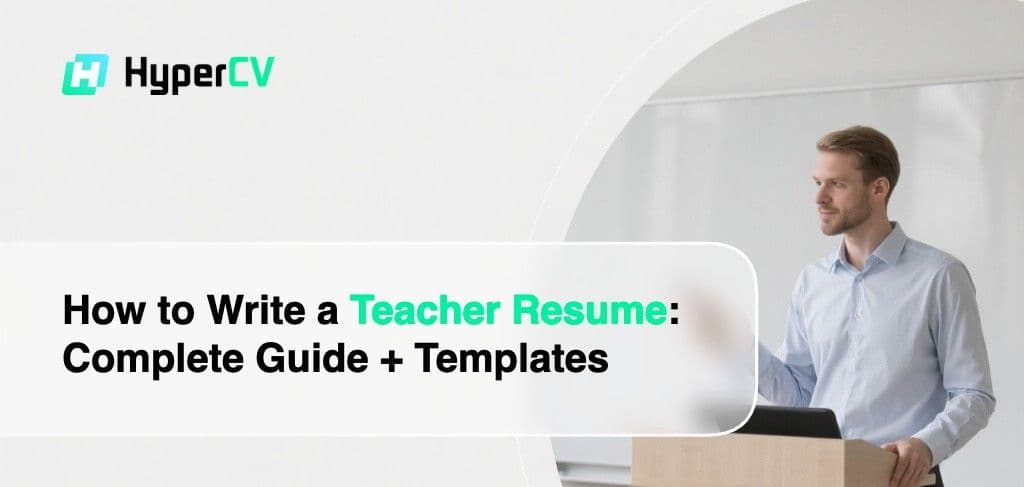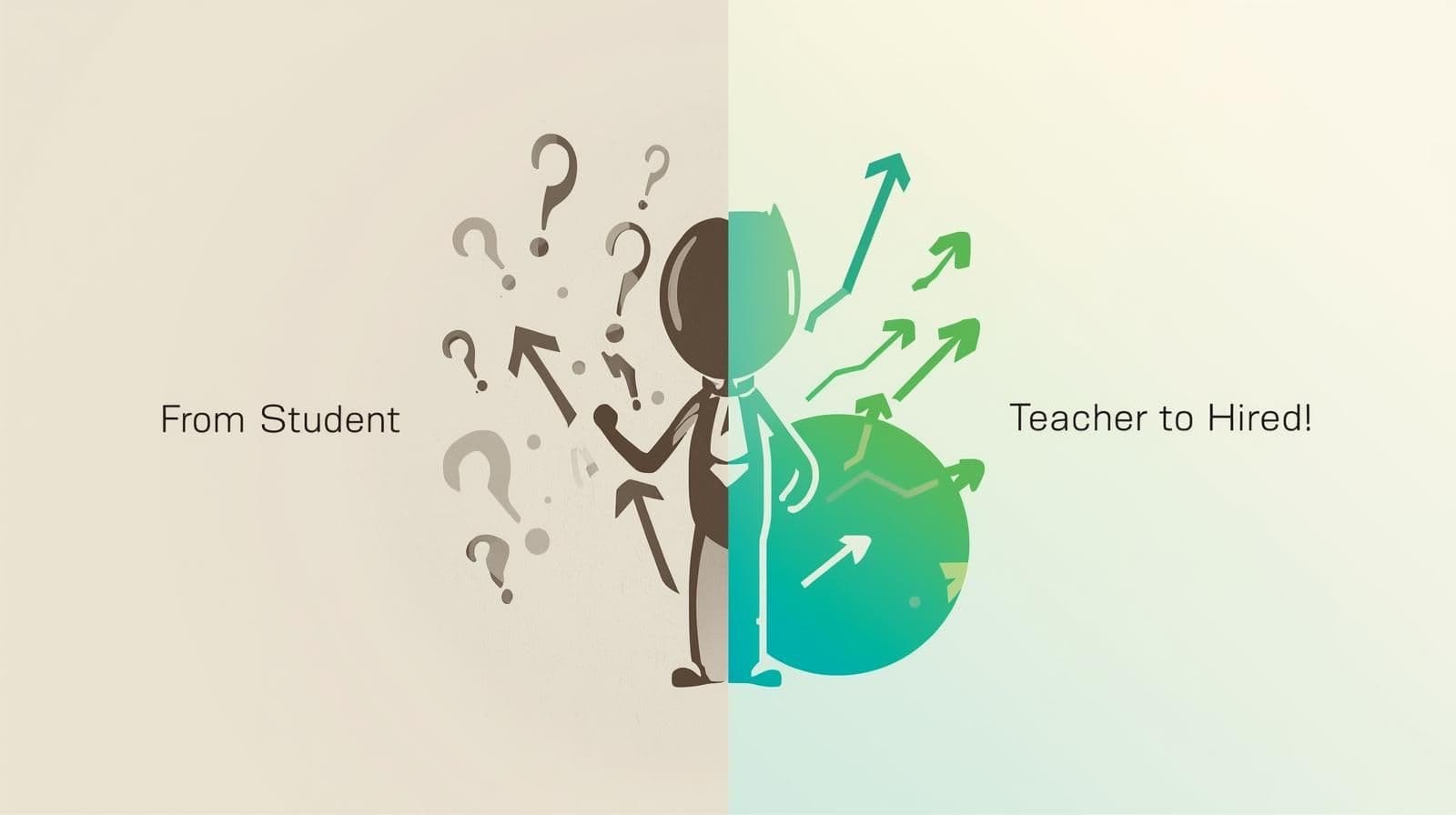How to Write a Teacher Resume: Complete Guide + Templates

Landing your dream teaching job starts with one simple but powerful tool: a great resume. Whether you're fresh out of college or switching schools, your resume is often the first chance to show what you can do in the classroom. The good news? Creating a strong teacher resume doesn't have to be overwhelming when you know the right steps to follow.
In today's competitive education field, your resume needs to do more than just list your qualifications. It should tell your story as an educator and show hiring managers why you're the perfect fit for their school. From highlighting your classroom achievements to choosing the right format, every detail matters when you're trying to stand out from other candidates.
Start with a Strong Professional Summary
Your professional summary sits at the top of your resume and sets the tone for everything else. This short paragraph should grab attention in just two or three sentences. Think of it as your elevator pitch – you want to showcase your best qualities as a teacher right away.
According to expert resume writers, your professional summary should highlight your teaching philosophy, key strengths, and career goals. Don't be shy about highlighting your accomplishments. Include specific details like how many years you've taught, what grade levels you've worked with, or any special recognition you've received. These facts help hiring managers quickly understand your background and experience level.
For Experienced Teachers: A seasoned educator might write: "Dedicated high school science teacher with 8 years of experience helping students excel in chemistry and biology. Successfully increased student test scores by 15% through innovative lab-based learning methods. Certified in AP Biology instruction."
For New Teachers: A recent graduate could say: "Enthusiastic elementary education graduate with hands-on student teaching experience in diverse classroom settings. Strong background in literacy instruction and behavior management. Committed to creating inclusive learning environments where every student can succeed."
Showcase Your Teaching Experience Effectively
The experience section is where you really get to shine. This is your chance to show the real impact you've made in students' lives and in your schools. Instead of just listing what you did every day, focus on your achievements and results.
As highlighted by professional resume writers, numbers and percentages make your accomplishments much more impressive. Did you help raise reading levels? Improve test scores? Start a successful after-school program? Include those details with specific data whenever possible.
Structure Your Experience Entries
For each position, include:
- Your job title and school name
- Location and dates of employment
- 3-4 bullet points highlighting your key achievements
- Specific results and outcomes when available
Example for Experienced Teachers: Fifth Grade Teacher, Lincoln Elementary School, Denver, CO | August 2019 – Present
- Develop and implement engaging lesson plans for classes of 28 students
- Increased student reading proficiency scores by 20% through targeted literacy interventions
- Collaborate with parents and administrators to support struggling learners
- Lead school-wide science fair committee, resulting in 85% student participation
Example for New Teachers: Student Teacher, Roosevelt Middle School, Phoenix, AZ | January 2024 – May 2024
- Assisted lead teacher with daily instruction for 120 seventh-grade math students
- Created digital learning materials using Google Classroom and educational apps
- Provided one-on-one tutoring support for students below grade level
- Helped implement new assessment strategies that improved student engagement
Remember, when listing your student teaching experience, focus on what you contributed instead of your responsibilities. Most teachers have some form of student teaching experience during their education, which you can totally include on your teacher resume.
Education and Certification Requirements
School administrators need to see that you have the proper education and credentials to teach effectively. Your education section should clearly show your qualifications and any additional training you've completed.
List your degrees starting with the highest level first. Include the degree type, school name, location, and graduation year. If you have a strong GPA (3.5 or higher), you can include it as well.
Education Format:
| Component | Example |
|---|---|
| Degree | Bachelor of Science in Elementary Education |
| School | State University, Columbus, OH |
| Year | 2023 |
| GPA | 3.8 GPA |
Certifications Matter
Teaching certifications and endorsements show your commitment to professional growth. List all relevant credentials, including:
- State teaching licenses
- Subject-specific endorsements
- ESL certifications
- Special education qualifications
- Technology integration training
Format these similarly to your education, with the certification name, issuing organization, and date received.
Highlight Your Teaching Skills
A well-organized skills section helps hiring managers quickly see what you bring to their school. Focus on both hard skills (like curriculum development) and soft skills (like communication) that are essential for teaching success.
Choose skills that match what the job posting asks for. If a school is looking for someone with experience in differentiated instruction, make sure that skill appears in your list if you have it. When creating a resume for a teaching role, it's important to highlight technical skills and soft skills.
Essential Teaching Skills to Consider:
Classroom Management Skills:
- Student behavior management
- Classroom organization
- Time management
- Conflict resolution
Instructional Skills:
- Lesson planning
- Curriculum development
- Assessment creation
- Differentiated instruction
- Technology integration
Communication Skills:
- Parent communication
- Team collaboration
- Public speaking
- Written documentation
Leadership Skills:
- Mentoring new teachers
- Committee participation
- Program development
- Student motivation

Choose the Right Resume Template
Your resume template should be clean, professional, and easy to read. Avoid fancy fonts or distracting graphics that take attention away from your qualifications. Remember, school administrators review many resumes, so yours needs to be scannable and well-organized.
Look for templates that:
- Use plenty of white space
- Have clear section headings
- Include room for your contact information
- Allow for easy customization
- Work well when printed or viewed on screen
A combination format works best for most teachers because it highlights both your skills and work experience. This format lets you showcase your strengths upfront while still providing detailed work history. You can find helpful guidance on how to pick the best teacher resume template to suit your specific needs.
Action Words That Make an Impact
The words you choose can make your resume much more engaging and powerful. Start your bullet points with strong action verbs that show your active role in student success and school improvement.
Strong Action Verbs for Teachers:
- Developed innovative lesson plans
- Collaborated with grade-level teams
- Implemented new assessment strategies
- Mentored struggling students
- Organized school-wide events
- Analyzed student performance data
- Created engaging learning activities
- Facilitated parent conferences
Tailoring Your Resume for Each Job
While it takes extra time, customizing your resume for each position significantly improves your chances of getting an interview. Read the job posting carefully and adjust your resume to match what the school is looking for.
Pay attention to:
- Required qualifications and preferred skills
- Grade levels and subjects mentioned
- School culture and values
- Special programs or initiatives
Use keywords from the job posting throughout your resume, especially in your summary and skills sections. This helps your resume get noticed by both human reviewers and automated systems that many districts use.
Resume Length and Formatting Guidelines
For most teachers, a one-page resume is ideal, especially if you have less than 10 years of experience. New teachers should definitely stick to one page, focusing on their most relevant qualifications and experiences.
Teachers with extensive experience might need two pages, but only if every piece of information adds value. Focus on your most recent and relevant positions, typically from the last 10-15 years.
Formatting Tips:
- Use consistent font sizes and styles
- Keep margins between 0.5 and 1 inch
- Use bullet points for easy scanning
- Save as both PDF and Word versions
- Proofread carefully for spelling and grammar errors
Common Mistakes to Avoid
Even great teachers can make resume mistakes that hurt their chances. Here are some pitfalls to watch out for:
Including too much personal information: Skip details about your age, marital status, or hobbies unless they're directly relevant to teaching.
Using generic statements: Instead of saying "responsible for teaching students," be specific about your methods and results.
Forgetting to quantify achievements: Numbers make your accomplishments more impressive and believable.
Neglecting to proofread: Spelling and grammar errors are especially damaging for teacher resumes.
Making it too long: Hiring managers spend just seconds scanning each resume initially.
Leveraging Professional Resources
Many professional resume writers specialize in helping teachers create standout resumes. For example, career strategists who focus on transitioning teachers can provide valuable insights into crafting compelling resumes that secure interviews and new job opportunities.
These experts often emphasize personalized service, practical tips, and proven strategies for resume writing, including crafting impactful professional summaries and highlighting teaching experience effectively.
Final Tips for Success
Creating an effective teacher resume takes time and thought, but the effort pays off when you land interviews at schools where you want to work. Remember that your resume is just the first step – it needs to open doors to conversations about your teaching philosophy and classroom experience.
Keep your resume updated throughout your career, adding new achievements and skills as you grow professionally. This makes it easier when new opportunities arise, and you won't forget important accomplishments over time.
Most importantly, let your passion for education shine through in every section. Schools want to hire teachers who are excited about making a difference in students' lives, and that enthusiasm should be evident from the moment they start reading your resume.
For additional resources and examples, consider exploring comprehensive teacher resume guides that offer templates, skills guidance, and writing tips specifically designed for educators at all career stages.